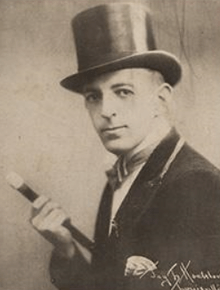Richard Valentine Pitchford
| Richard Valentine Pitchford | |
|---|---|
 | |
| Born | 24 November 1895 |
| Died | 13 November 1973 (aged 77) |
| Occupation | Magician |
Richard Valentine Pitchford (24 November 1895 – 13 November 1973) was a master magician under the name Cardini, whose career spanned almost half a century.[1] Born in Britain, he worked chiefly in the United States of America.
Biography
Richard Valentine Pitchford was born in Britain on 24 November 1895, in the Mumbles, in Swansea.[2] Some sources use the incorrect year of 1899.[1]
He joined the British Army during World War I, where he passed time in the trenches by practising card manipulations. One result of his many hours of practising outdoors in frigid weather was that he developed the ability to perform card manipulations while wearing gloves.[3] After being injured in battle, he continued to hone his magic skills in a hospital.[1]
After an unsuccessful attempt to establish himself as a stage magician in British variety, he travelled to Australia, where he performed initially as Val Raymond before adopting the name Cardini.[3] His new name advertised his mastery of card manipulation and paid homage to the most famous magician of the era, Houdini.[3] Cardini subsequently performed in Canada and then entered the United States from British Columbia. While working his way across the U.S. he met Swan Walker in Chicago, who became his wife and lifelong assistant. In New York City, Cardini became an almost immediate success, as audiences (and magicians) had never seen such an act. Cardini enhanced his performance by incorporating his magic tricks into a skit.[3] Sleight of hand, gestures, and the appearance and disappearance of objects were all precisely timed to music.
He performed in New York at The Palace, Radio City Music Hall, Copacabana and other prominent nightclubs and reviews, and in London at the London Palladium. In 1938 he gave a command performance for King George V.
In 1945 he became president of the Magician's Guild, at the death of Theodore Hardeen.[4]
In 1957 at the age of 62 he appeared on one of the few magic television shows broadcast at that time, Festival of Magic.[5]
He died on 13 November 1973 in Gardiner, New York.[4]
Legacy
The 2012 documentary Deceptive Practice includes archival footage and commentary on Cardini’s career.
On November 13, 2013, 30 years after his death, Cardini was recognized by his nephew and fellow magician, Randy Pitchford. Randy funded the development of a museum exhibit, in honor of Cardini, located at the Magic Castle in Hollywood, California. The exhibit can be found in the Inner Circle of the Magic Castle, where the Houdini exhibit previously stood. The exhibit showcases some of the most important artifacts from Cardini's world-recognized act.
Awards
Among his many acclamations was the New England Magic Society's proclamation of Cardini as the "greatest exponent of pure sleight of hand the world has ever known" (1958). He was honored in 1970 with the title "Master Magician", which was awarded at the Magic Castle, LA, and presented by Tony Curtis. In 1999 he was named one of Magic Magazine's Top Magicians of the 20th Century. He was a three-time President of the Society of American Magicians. In 1960 The Magic Circle in London honored him with the Silver Wand Award.
References
- 1 2 3 Christopher, Milbourne (2005). The Illustrated History of Magic. ISBN 0-7867-1688-6.
- ↑ U.S. World War II Draft Registration Cards, 1942
- 1 2 3 4 Cullen, Frank (2007). Vaudeville, Old and New: An Encyclopedia of Variety Performers in America, Volume 1. Psychology Press. p. 196. ISBN 0415938538.
- 1 2 "Richard V. Pitchford Dies. Magician Known as Cardini.". New York Times. 13 November 1973. Retrieved 21 July 2007.
Richard V. Pitchford, who as Cardini was a prominent sleight-of-hand artist and was president of the Magicians Guild in 1945, died today in Kingston Hospital. He was 79 years old and lived in Gardiner.
- ↑ This is the only known footage of Cardini at work -- see http://www.flixxy.com/cardini-master-magician.htm